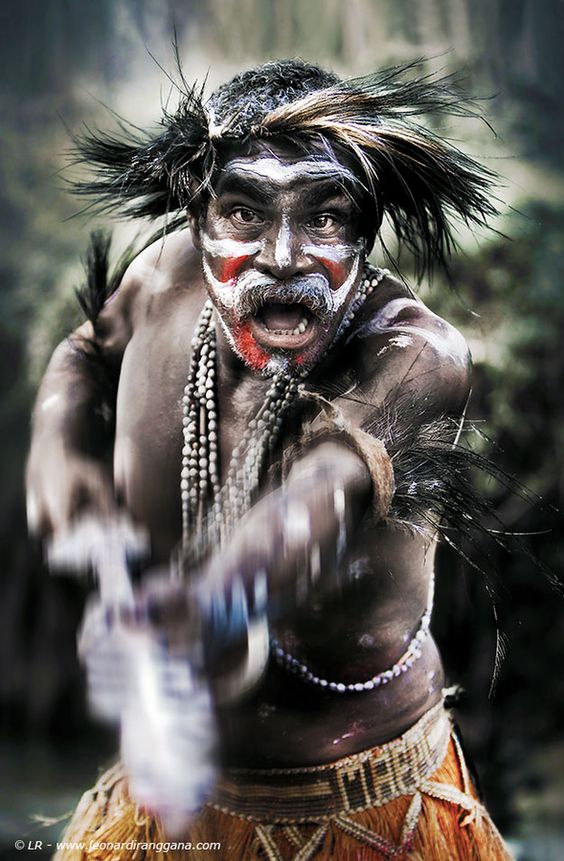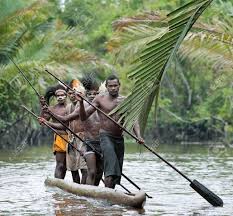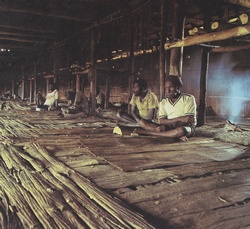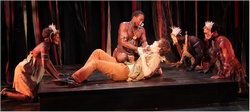The Asmat
In some ways the Asmat are the most famous of the hundreds of ethnic groups in Papua. Their traditional territory is the southwestern coastal area along the Arafura Sea and inland through swamps, mangrove forests, rivers, and lowland rainforest. The environment is harsh; mud is a daily irritant. The jungle is heavily overgrown and difficult to navigate. The waters of the Arafura Sea have sharks and poisonous sea snakes to contend with and large crocodiles are a constant danger not only in the rivers and sea but also in the villages, as crocodiles sometimes come on land in search of food.
Part of their territory is the Lorentz National Park and World Heritage Site. Wildlife include boar, domesticated dogs, snakes, crocodiles, lizards, rats, flying foxes, hornbills, cockatoo, crown pigeons and the bird of paradise. Others include turtles, shellfish, and fish. Lifespans tend to be shorter than in most other parts of Indonesia due to this harsh environment. Diseases include malaria, amoebic dysentery, bronchial problems and a variety of infections.

History
First contact with the Asmat dates back to 1623 with the Dutch trader Jan Carstensz. James Cook landed in Asmat territory in 1770 with the HM Bark Endeavor, but the landing party quickly departed when confronted with hostile Asmat warriors. A small outpost was set up by the Dutch in 1938, but not much happened there, and it was abandoned when the Japanese arrived. It wasn't until 1953 with the founding of a Catholic mission that any real presence of outsiders became established. The Catholic missionaries still play a large role in the life of the Asmat. Over the last few decades Asmat have begun to interact more with the outside world and some Asmat have left the area for other parts of Indonesia to pursue higher education.
Settlements
Asmat population is somewhere around 70,000. They live in perhaps 100 villages around the coast and inland sites alongside bends in rivers. This is so that they can easily spot an enemy coming to attack. The main city in Asmat is Agats. It's on the bank of the Asewetsj River just at the opening to Flamingo Bay. The last time that I was there, the city didn't have much to offer. The main street was built on top of pilings and was made of wood. I always had the feeling that I was going to fall through the street and end up in the swampy mess below, a treat for some waiting crocodile. It was a very unusual place even for Papua.

Land travel is extremely difficult, so most traveling in the area is done by river. Thus, canoes are very important to the Asmat; large canoes for war and families can be as long as 20 meters, women and children have shorter ones that are easier to maneuver. Canoes are paddled from a standing position and the men are arranged in the canoe by order of rank. The building of a canoe is an important undertaking. Men travel into the forest to find a suitable tree which they cut down. They begin shaping the canoe on site. After they have a rough shape, they float the log to the village where the work is completed. A specialist carves the prowhead with representations of dead ancestors or animals of the area.
Because of the extremely strong tides in this region and because the land is low lying, houses are built on stilts to prevent them from flooding. Villages were large for protection and often included several clans. Disputes between clans sometimes led to the establishment of a new village and a new enemy. There could be hundreds of people living in one village. The men's house, the jeu (pronounced jayu), was the center of social life. These were clan based, rectangular in shape and held many doors that led to fire pits for keeping food warm, lighting cigarettes, use in carving and warmth and safety in the night from marauding spirits. A jeu could be as long as 90 meters. Women were not allowed to enter the men's house. They have small family houses where they live.

All important decisions - religious, political, planning a raid - were made here. Fire pits were arranged according to status. Woodcarving was done here as was boat building. The Indonesian government decided to stamp out the jeu in 1964 in an ill-advised attempt to modernize the Asmat. Ceremonies were banned, woodcarving was banned and jeu were burned down. The Catholic missionaries attempted to convince the government not to proceed with their modernization project but were unsuccessful. Many of the Asmat fled and moved deeper into the forest, away from the control of the government. By 1974 the program ended and with the participation of the Catholic mission and the United Nations a revitalization of traditional culture began.
The Asmat are actually made up of 12 sub-groups spread around the land that is also called Asmat. Historically, these groups frequently were at war with each other, although the presence of missionaries and the Indonesian military have slowed down the pace of these conflicts. Reading Indonesian newspapers, you can still come across stories of a small battle over some seemingly minor issue.
So, the Asmat are known for an unlikely range of things: cannibalism, head-hunting, woodcarving and the disappearance of Michael Rockefeller back in 1961. Let's look at the Rockefeller thing first. Rockefeller was the son of Nelson Rockefeller who was the governor of New York at the time.  The Rockefellers are old American money for those of you not familiar with them. Michael had been in Papua with the Dani expedition first and then moved down to Agats where he was looking for Asmat carvings to bring back to New York. He went out one day in an outboard catamaran with a few guides and the boat capsized due to the intensely strong tides in the area. A few miles out a sea, Rockefeller could see land and eventually decided to make a swim for it. A rescue party showed up a few hours after he left. Rockefeller was never seen again. A massive international search began scouring both land and sea. But no Rockefeller.
The Rockefellers are old American money for those of you not familiar with them. Michael had been in Papua with the Dani expedition first and then moved down to Agats where he was looking for Asmat carvings to bring back to New York. He went out one day in an outboard catamaran with a few guides and the boat capsized due to the intensely strong tides in the area. A few miles out a sea, Rockefeller could see land and eventually decided to make a swim for it. A rescue party showed up a few hours after he left. Rockefeller was never seen again. A massive international search began scouring both land and sea. But no Rockefeller.
Stories have been built up over the years about what happened to him. While it seems most likely that the strong tides overwhelmed him and he drowned, the more popular story was that he had been captured by an Asmat group and had been killed and eaten. There is some circumstantial evidence to support this story: a pair of glasses found in the area, a backpack, some clothes, but nothing definitive. An Asmat group in the area where he would likely have washed ashore, had a grudge against the white tribe that had never been settled and according to Asmat beliefs, the tribal members who had been shot by a white expedition a few years earlier had never been avenged so there ghosts would still be wandering about creating mischief for their relatives and tribal members. 50 plus years later and this story still goes unsolved. OK, on to head-hunting.
Headhunting/Religion/Magic
Headhunting was an important part of the culture until not so long ago and of course rumors still float around that back deep in to lowland rainforest and marshes, it still is practiced. I was in Agats, a center of Asmat, buying some carvings when an old man came up to me and asked if I'd like to purchase a head. I knew that in the past the men's houses would have skulls around, sometimes being used as pillows. So, I shrugged, said sure. He reached into his bag and pulled out this wooden skull. I bought all four that he had, somewhat relieved that I didn't have to try to smuggle a human skull back on the plane to Timika.
Head-hunting grows out of the Asmat's animistic religion. In order for life to proceed prosperously, a balance needs to be maintained with the spirit world. Spirits inhabit everything- rivers, rocks, trees, animals, ancestors. Some spirits are good, some bad, some mischievous, some temperamental. In other words, spirits are pretty much like people except that they have tremendous power that can be beneficial to the people or can destroy them. Human skulls have power to protect the living. When a family member dies, their skull will go to the oldest child. That skull will be decorated, touched, stored in a safe place, used as a pillow, talked to, taken to ceremonies, consulted about important decisions.
Enemy skulls provided the warrior who killed them with power in war, as well as a tasty helping of brains which were mixed with grubs from the palm tree. This was quite a treat so it is said. Skulls can be placed in the palm trees that produce the sago that is the main part of the Asmat diet. The skulls will ensure a good harvest of sago from the tree. Enemy warriors who were captured were tied up in a canoe, taken to a good place for dispatching them and then were decapitated.
The Indonesian government and the missionaries put an end to head-hunting and cannibalism. This put the culture under some stress as they attempted to adapt to new conditions, to find some other means to place their energy and need for physical aggression. Taking a human head is a religious act. It releases an ancestor from the land of the living and allows them to move on to
Like many other tribes in Papua, Asmat believe that all deaths are caused by some enemy either from a visible adversary with a bow and arrow or a spear or by unseen adversaries using magic or even by one's unhappy ancestor who demanded revenge for his death. Magic is the usual answer for all of these plagues and can be caused by a disturb ancestor, a jealous neighbor, an offended animal spirit or an enemy from a neighboring village. Animism is the belief system and co-exists with Catholicism. All objects both animate and inanimate have power to affect the lives of the Asmat people. This environment and the creatures and spirits that inhabit it are the subjects of Asmat art.
Art
Asmat carving is known throughout the world. Rare at one time, today there are international buying festivals in Asmat and its easy to find Asmat carvings in Bali, although many of them are fakes. While all men were able to work on canoe and house building, the best carvings are done by specialists who have almost as much status as a warrior, these days probably more. These carvers would be sought after to make a shield for war, an ancestor pole, or some other carving done usually to placate an ancestor. The completed carving would be given the name of an ancestor and this would insure that they would remain happy and prove beneficial to their descendants. Carvings would not be paid in money, but rather would be supported while they were working on a project. This could sometimes take months. A carver would be given food and tobacco, and his family would be fed as well. Out of a village of 1000 maybe only 10 men would be considered master carvers.

The Asmat believe they were created from wood; this is shown in their main origin myth. The first man in the world was named Fumeripits. He was alone and as humans tend to be, he was lonely all by himself so he decided to create some companions. By the way, he also created the first men's ceremonial house, the jeu. So here he was alone; he would spend his days dancing on the beach, but eventually his loneliness overcame him so he chopped down some trees and created some human figures, and he placed them in his jeu. But, being wood, they did nothing, offered no companionship. So he cut down another tree and made a drum. He played his drum in the jeu and they came to life. This position, elbows on knees is considered how people came into the world and how they are positioned when they leave it. Their arms became unstuck from their knees and they arose and began to dance. And, so the first people were made of wood.
Social Organization
Men practice polygyny and would marry a relative's wife should he die. Sororal polygyny is often practiced because sisters tend to get on better than wives who are unrelated. A younger wife can often have a difficult time at first. Homosexual relationships were common as well for men who would take a younger male in a mentor/friendship/sexual relationship.
Leadership is male-based and dependent on skills and age. It is not hereditary. This is a system of merit. A strong warrior traditionally held the highest status, but these days a master carver has high status, in part because of the cash income that he can generate.
Economy
Traditional economic activities for the Asmat were hunting, gathering, and fishing. Sago is the staple part of the diet. Corn starch from a palm tree. Sago gathering is a community activity with the parents taking their children. This has become something of an issue these days because of schooling. For the Asmat will built a small dwelling where they will live until the sago is harvested. As much as 35 kilos of sago can come from one tree. These are carried in five kilo baskets after it is processed on site. Some palms are deliberately slit to allow the Capricorn beetle to lay eggs in them. These turn into sago grubs which are eaten raw or cooked.
Modernity
The Asmat are moving into modernity with the assistance of the Catholic Church in Agats, as well as the Indonesian government and NGOs that encourage the Asmat to support their children's education. Some members have already gone on to higher education both within Indonesia and in Europe as well.

